Top College Landscape Design Trends

Design Guide | May 25, 2022
Landscaped outdoor spaces at your college stand out in visitors’ minds and give the staff and students relaxing places to study or socialize. They make the campus more attractive, peaceful and practical. Outdoor spaces can serve a number of purposes and even benefit the environment.
Designed outdoor areas provide outdoor workspaces, encourage socialization, enhance campus aesthetic and promote relaxation. This helps attract new students and improve the experience of existing students and faculty. As a result, you’ll find that everyone who frequents your campus will want to spend as much time as possible on it.
Read on to learn more about recent college landscaping trends that will help your campus stand out and serve the needs of its community.
Table of Contents
1. Common Areas
Any space that is available to any student of the college is technically a “common area.” College campuses often have multiple common areas that are gathering spaces near locations with high traffic.
This could be the space under the overhang of a busy building, a grassy area next to a main walking path or an eating space outside of the cafeteria. If the college already has outdoor common areas that students and staff are spending time in, you can make those spaces more comfortable and accommodating.

These high-traffic areas need seating, shade and trash receptacles. When people are waiting for class to start or a friend to show up, they gather in these common areas. Providing plenty of comfortable benches is a necessary first step. There are traditional park benches that add charm and steel benches that add color. Whichever style you choose, try to accommodate as many people as you can.
If the area isn’t already shaded by buildings or trees, consider adding other shading elements. You can choose tables with shade, shaded benches and commercial umbrellas. Providing shaded areas will allow people to use those areas more safely when the ultraviolet (UV) index is high.
Providing access to trash receptacles is essential in maintaining campus cleanliness. People are much less likely to throw trash on the ground when they can see a nearby trash can. Be sure to provide easy access to trash cans and recycling cans in common areas so everyone has an easier time keeping the campus clean.
2. Relaxation Areas
Higher education is often stressful and anxiety-inducing. Students and staff alike can benefit from special relaxation areas that are designed to help reduce environmental stressors. Landscaped outdoor spaces are perfect for this — spending time in nature has been shown to improve physical wellness, mental wellness and wellness in the community.
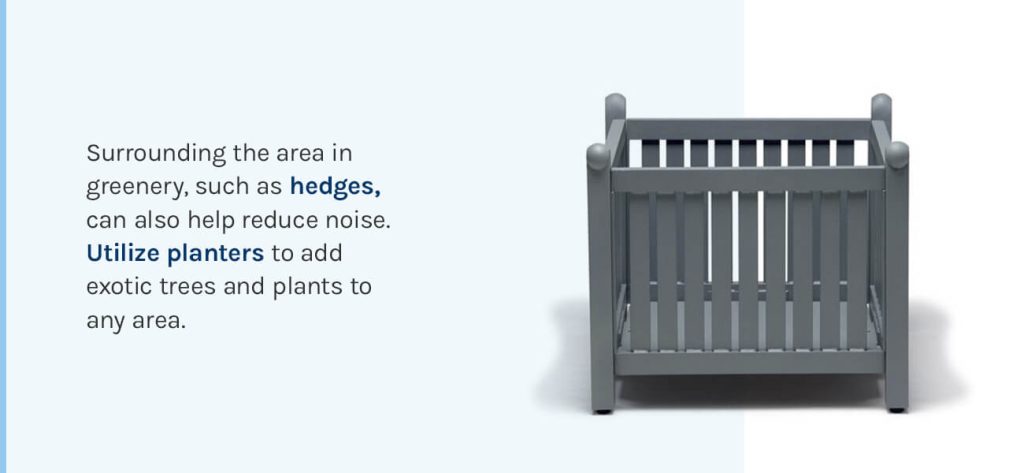
Unlike common areas, relaxation areas are placed away from high-traffic areas. These spaces should be as quiet as possible, especially if your college is in an urban environment. Water features can be used to help drown out unwanted noises. Surrounding the area in greenery, such as hedges, can also help reduce noise. Utilize planters to add exotic trees and plants to any area.
Comfortable tables and chairs and adequate shade are important in these areas. Just like with common areas, you want people to be comfortable. However, because people are likely going out of their way to find these peaceful areas, going the extra mile can make a big difference. Add outdoor furniture with cushions, hammocks and lounge seating to set the space apart. Consider placing signage that encourages the community to stay quiet in these relaxation zones.
3. Study Areas
Outdoor study areas can give students a peaceful environment to read and write in. Sometimes, the library is crowded, the dorm is too loud or other study areas are simply inaccessible. Having outdoor spaces that give students an extra place to do their work is the perfect way to provide an alternative.
Study and relaxation areas can sometimes share the same space if needed. After all, many students study individually. However, some study areas should be more conducive to group work. Students often have group projects or collaborative assignments and need to meet their group members somewhere.
Include tables that are spaced out enough that groups won’t be interrupted by other conversations. Placing these areas near the library and dorms is a great way to make them accessible to the students who need them.
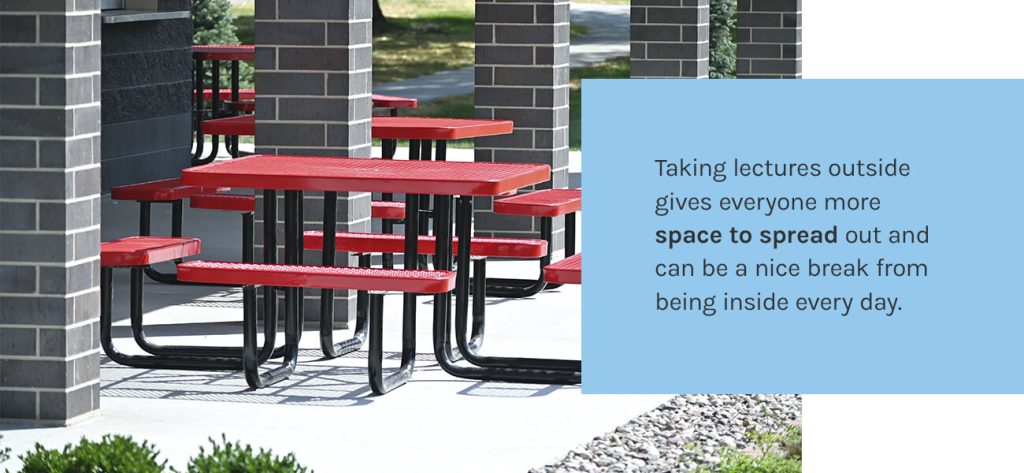
You can also include spaces that could serve as an outdoor classroom. Outdoor classrooms are another up-and-coming trend in the higher education sector. Taking lectures outside gives everyone more space to spread out and can be a nice break from being inside every day.
Outfit the area with multipurpose furniture that students and staff can move around as they wish. This allows the classroom to serve whatever purpose the instructor needs. Adding electrical outlets is also important to ensure everyone can still use their devices outside.
4. Activity Areas
Activity areas are essential for higher education institutions. Students need a place to throw a frisbee or football, play outdoor games and otherwise blow off steam. Of course, exercise is important for staying healthy and reducing the effects of stress. Providing these areas to students makes it easier and safer for them to participate in physical activities while socializing and enjoying the outdoors.
Activity areas can be anything from open grassy spaces to sports courts. Any place that can be used for different activities is beneficial to students. They should be placed a little bit away from walking traffic. Include benches so people can take a break or watch the game. If the area is farther away from campus, include a walking path or biking path between areas.
Large open activity areas can also be used for fairs. Colleges often have club fairs, where students can stop by extracurricular tables and sign up for different clubs. These areas can also be used for job fairs, when employers come to the school to recruit students. When there are no events, the space can continue to be a place for students to throw a ball or watch a game.
5. Walking Trails
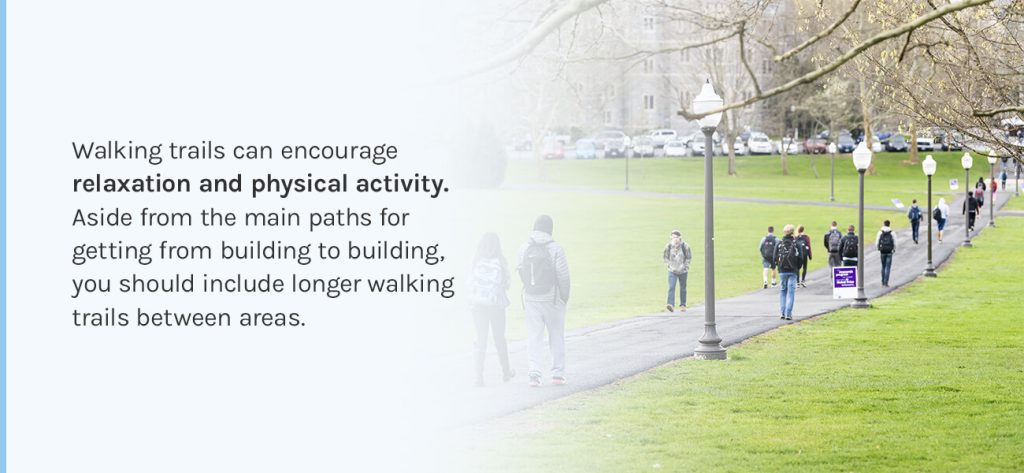
Walking trails can encourage relaxation and physical activity. Aside from the main paths for getting from building to building, you should include longer walking trails between areas. Students are often sitting for hours at a time, and walking paths give them a peaceful place to stretch their legs.
These trails can be walking loops around a large area or just longer paths that connect different places on campus. Of course, some students will always want to take the faster route. Still, including some detours allow others to take the scenic route and have a chance to get some healthy exercise outside.
Walking trails should include amenities such as benches and trash receptacles. Benches will give tired students a place to rest, and trash receptacles help keep the trail clean. Remember to include enough lighting so people can feel safe walking during the early morning and evening hours. If you also choose to add a bike path, maybe from campus housing to the main campus, remember to install bike racks.
6. Community Zones
Give your students and faculty a place to interact with each other through community zones. A community zone can be something like a community garden, fire-pit patio or anything that stimulates people to gather. These spaces allow people to meet new people and make connections. Students who attend schools with a strong sense of community can reap many benefits, especially when it comes to life after graduation.
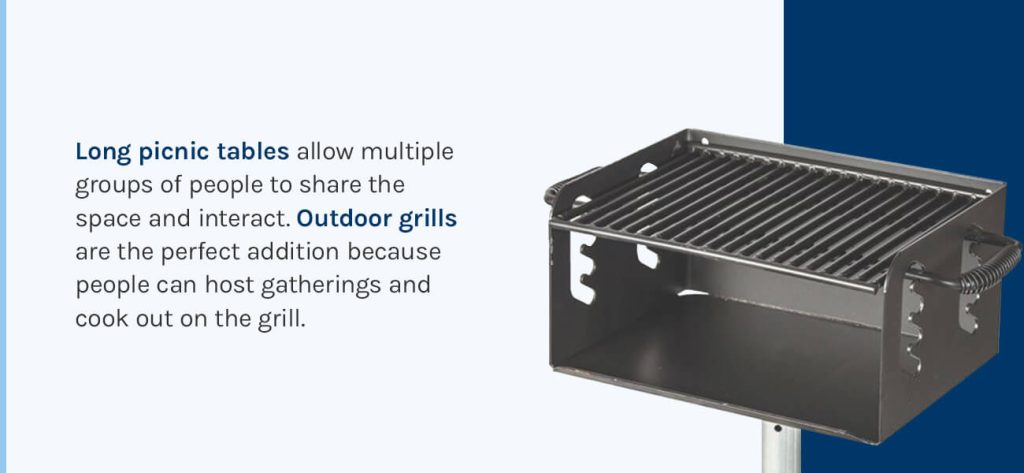
Create a community zone with picnic tables and grills. Long picnic tables allow multiple groups of people to share the space and interact. Outdoor grills are the perfect addition because people can host gatherings and cook out on the grill. Including enough seating and grills is important so everyone can share the space while still interacting with each other.
You can also include game tables in your community zone to encourage people to play games with each other. These unique elements can pull more people into your community zone and encourage positive interactions between them. You can even plan and host game events to bring more people together.
7. Culinary Gardens
Food and vegetable gardens on campus are a growing trend. Many students today are more aware of pressing environmental problems and feel like they need to do something to help. Campus gardens provide an outlet for this concern and allow them to connect with the land.
All students can come together to make a difference in the environment, even if they’ve never gardened before. These gardens can provide food for campus dining halls, which can offset the cost of funding the garden and dining costs in general. Excess food can also be donated to local food banks or used for a campus food pantry, leaving a positive impact on the community.
8. Water Features
Water features can be incredible pieces that create good first impressions and promote feelings of well-being. They can enhance the landscape while speaking to people’s sensory needs through sight, sound and even touch. Water features with a lot of movement can help drown out unwanted noise and create a more relaxing ambiance. They’re beautiful to look at and often serve as landmarks for the community.
The area around the water feature will often be a meeting place for students or an area to hang out and enjoy the ambiance. Including plenty of beautifully landscaped areas and top-notch lighting can make the area perfect for taking photos in an already eye-catching spot. The more photo opportunities there are for your visitors, the more word-of-mouth marketing there is for your college.
Additionally, remember to place seating so that people can hang out or wait for others around the water feature.
9. Eye-Catching Colors
A great way to spruce up your campus landscape is to include pops of color. Alongside the greenery, there should be flowers, interesting plants and colorful trees. You can even include plants that match your school colors or plant them in a way to create an image of the logo or team mascot.
This can make your campus a marketing point and help create a cohesive look. There are endless options when it comes to including greenery and color in your landscape. Color helps to make the landscape more appealing.
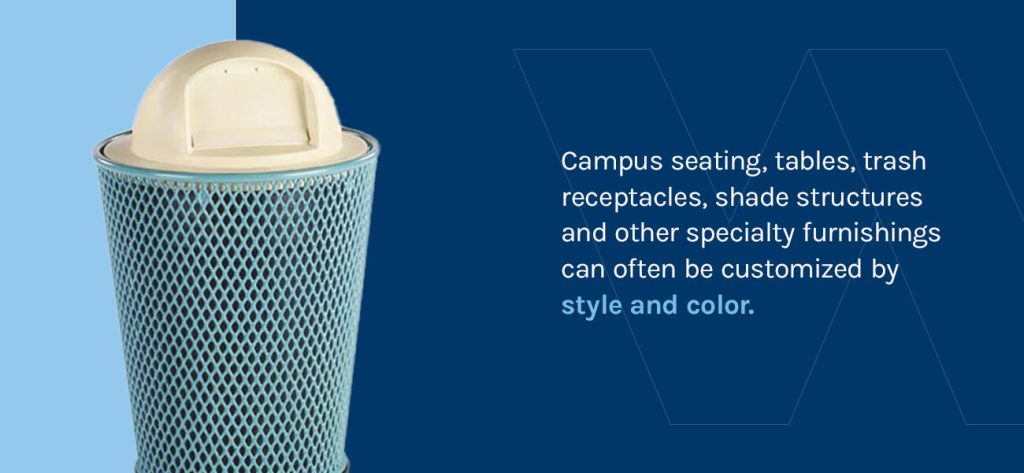
You can also use color in your amenities and outdoor elements. Campus seating, tables, trash receptacles, shade structures and other specialty furnishings can often be customized by style and color. This allows you to create a style that separates your campus from the surrounding environment. Contrasting the colors of the natural elements and your amenities can help create appealing spaces that really pop.
Wabash Valley Site Furnishings offers different collections that share the same style and customization options. For example, our Camden collection offers powder-coated tables and benches that come in a variety of dark color options, while the Prestige collection offers plastisol-coated elements with brighter color options.
10. Year-Round Appeal
When planning your landscape, you need to consider year-round appeal. Your campus shouldn’t just look good in the spring when the flowers are blooming — it should look good all year since students will be there for most of it. Different plants and trees can add color in each season, so it’s necessary to include a good variety. Other elements, such as water features and site amenities, can help enhance the landscape throughout the year.
Part of keeping a year-round appeal is landscape maintenance. All the hard work put into campus landscaping will be quickly overlooked if you fail to have a proper maintenance routine. Plants need watered, trimmed and cared for. Sidewalks and paths need to be swept and greenery should be cut back. Make sure you have staff members who have time for a maintenance routine.
11. Accessible Paved Paths
High-traffic areas that aren’t paved end up being trampled, muddy messes that aren’t appealing or practical. There are likely many places on your campus that could benefit from an installed path.
Pavers and stepping stones can be eco-friendly, practical and interesting additions to your campus. Permeable pavers allow water to drain through them, which helps prevent standing water and slippery conditions. They can also enhance the aesthetic of the entire landscape.

If you know the campus needs more paths but aren’t sure where to put them, look no farther than “desire paths.” These are the paths students carve out themselves as they go from place to place. When going around campus, you may notice trampled spots or students cutting through the grass in certain areas.
As time goes on, these dirt paths become obvious as more and more students decide that’s the better way to go. When you find signs of desire paths, you can make them official and pave the path or install attractive pavers.
12. Shade
Sunburn can occur in as little as 11 minutes of UV exposure during peak hours. If your students and faculty will be spending any time outside, they must have options for shade. Of course, buildings and trees can provide shade, but these aren’t likely to provide enough shade to keep the community comfortable and safe when they’re enjoying the outdoors.
Fortunately, there are many ways to include shade on your campus. There are shaded tables and benches you can conveniently place in areas that need shaded spaces. There are large shade structures that can shade an expansive area or options for using commercial umbrellas around campus. Other outdoor structures that provide shade, such as gazebos, pavilions or canopies, can also be spread across your campus.
13. Lighting
Landscape lighting can highlight the more beautiful parts of your campus’s landscape and create impressive scenes. Shine a light on eye-catching fountains, historical markers and appealing flower gardens. Lighting helps draw the eyes to certain parts of the landscape, making it appear even more beautiful.
You also need lighting for safety reasons. Many students will be on campus after dark, so outdoor lighting is essential. Dimly lit parking lots and walkways make students feel unsafe and can make crimes more likely. Lighting pathways also helps reduce the risk of tripping and falling on unseen hazards.
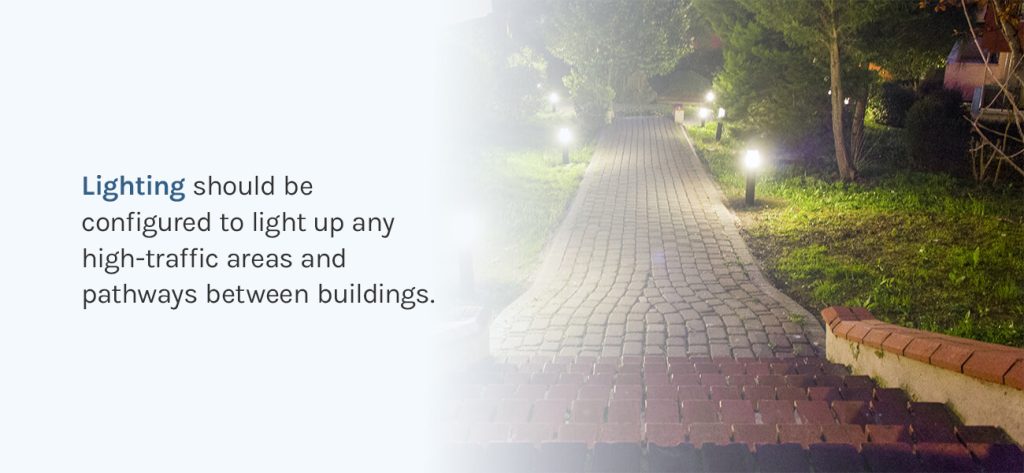
Lighting should be configured to light up any high-traffic areas and pathways between buildings. Students attending evening classes should feel safe walking to and from their classes and dorms.
Outdoor spaces like common areas and study zones should also have adequate lighting during all hours. Students often spend time outside after dark, especially during warmer months, so keeping those areas lit is important. Use low path lights, overhead street lights or a combination of different lighting.
14. Sustainability
Landscape design can also help your college reach its sustainability goals. According to the Sustainable Campus Landscape Guide, sustainability means incorporating nature into the landscape, restoring ecologies, increasing biodiversity and promoting human health, while still improving the beauty of the campus.
Sustainably managed landscapes provide oxygen, improve air quality and reduce hot temperatures. They can reduce stormwater runoff, prevent erosion and even provide physical benefits to those who engage with the landscape. “Living labs” can give students and staff an opportunity to conduct hands-on research.
Sustainable greenspace is a significant trend in higher education settings as younger people become more interested in preserving the environment. From environmentally friendly pavers to rain gardens and LED lighting, there are dozens of ways to meet your sustainability initiatives.

Learn More About College Landscaping With Wabash Valley
Creating the right atmosphere is a multi-step process, but choosing the right site furnishings supplier is the first step. Wabash Valley Site Furnishings can help your college meet your campus goals by providing stylish, durable and safe amenities.
Selecting our furnishings comes with a number of benefits, such as:
- Variety of styles: We have a number of furniture collections that showcase different styles, allowing you to choose what’s best for your campus.
- Durability: Our state-of-the-art facility produces products that are built to last. All of our products are designed to withstand high traffic and harsh weather.
- Customization options: Many of our products come in a variety of color options. This array allows you to create a cohesive brand image throughout the whole campus.
- Bulk pricing: Our bulk offerings allow you to get all the furnishings you need at an affordable price.
Wabash Valley Furnishings offers site amenities such as benches, dining sets, tables, planters, litter receptacles and much more. Our experienced team has worked with landscape architecture and design firms to put together site amenities and furnishings for a wide range of projects. We’ll work with you to create a bulk order that fits your specifications, design and budget.
Contact us to learn more about taking your campus to the next level with commercial site furnishings.
Categories
Recent Posts
Sign up for our newsletter
Share this post: